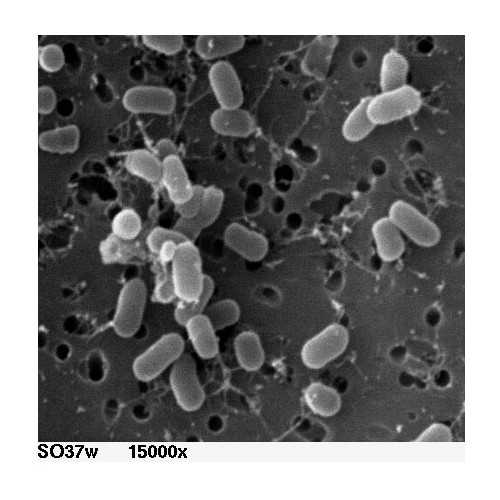pSVJ21 Psychrophilic Bacterium Shuttle Vector
The pSVJ21 shuttle vector provides a cloning system that can be used both with E. coli and high G+C Gram-positive psychrophilic (cold-loving) bacteria. In combination with the efficient electroporation protocol, this vector can be used for low temperature expression of cold-active enzymes in high G+C Gram-positive hosts, and for genetic studies of Gram-positive microorganisms.
Highlights:
- High structural and segregational stability at low temperature in psychrophilic Gram-positive hosts
- pUC18 functionality, integrated with native p54 plasmid of an Arthrobacter agilis strain GIC54 isolated from a 3042 m deep Greenland glacial ice sample.
- Can be transformed and maintained in E. coli DH5a using conventional procedures and selection for ampicillin resistance
- Efficient electroporation protocol shown successful for specifically selected isolates from Greenland and Antarctica related to Arthrobacter, Microbacterium, Curtobacterium, and Rhodoglobus using chloramphenicol resistance selection
The pSVJ21 shuttle vector was constructed by ligating p54 and pUC18 and inserting a 1.3 bp CAT cassette conferring resistance to chloramphenicol (cm). The resulting 6002 bp construct contains genes for ampicillin and chloramphenicol resistance and replicons for both Gram-positive and Gram-negative bacteria. The segregational stability of the vector in three Gram-positive recipients under non-selective conditions was higher at 5C than at 25C, making them suitable candidates for protein expression at low temperature.
From the laboratory of Jean Brenchley, PhD, Penn State University.
 Part of The Investigator's Annexe program.
Part of The Investigator's Annexe program.
The pSVJ21 shuttle vector provides a cloning system that can be used both with E. coli and high G+C Gram-positive psychrophilic (cold-loving) bacteria. In combination with the efficient electroporation protocol, this vector can be used for low temperature expression of cold-active enzymes in high G+C Gram-positive hosts, and for genetic studies of Gram-positive microorganisms.
Highlights:
- High structural and segregational stability at low temperature in psychrophilic Gram-positive hosts
- pUC18 functionality, integrated with native p54 plasmid of an Arthrobacter agilis strain GIC54 isolated from a 3042 m deep Greenland glacial ice sample.
- Can be transformed and maintained in E. coli DH5a using conventional procedures and selection for ampicillin resistance
- Efficient electroporation protocol shown successful for specifically selected isolates from Greenland and Antarctica related to Arthrobacter, Microbacterium, Curtobacterium, and Rhodoglobus using chloramphenicol resistance selection
The pSVJ21 shuttle vector was constructed by ligating p54 and pUC18 and inserting a 1.3 bp CAT cassette conferring resistance to chloramphenicol (cm). The resulting 6002 bp construct contains genes for ampicillin and chloramphenicol resistance and replicons for both Gram-positive and Gram-negative bacteria. The segregational stability of the vector in three Gram-positive recipients under non-selective conditions was higher at 5C than at 25C, making them suitable candidates for protein expression at low temperature.
From the laboratory of Jean Brenchley, PhD, Penn State University.
 Part of The Investigator's Annexe program.
Part of The Investigator's Annexe program.
| Product Type: | Plasmid |
| Antibiotic Resistance: | Ampicillin (amp), Chloramphenicol (cm) |
| Buffer: | Liquid (10mM Tris pH 8) |
| Concentration: | 150 ng/uL |
| Grow in E. coli at 37 C: | Yes |
| Selectable markers: | Amp and cm in E. coli, cm in Gram-positives |
| Vector Backbone and Size: | pSVJ21, 6002 bp |
| High or low copy: | high copy in E. coli, low copy in Gram-positives |
| Storage: | 4C or -20C |
| Shipped: | Ambient temperature |
Transformation Protocol: As a starting point, transform the plasmid in E. coli using either competent cells or electroporation and selection on LB agar with ampicillin (100 µg/ml or chloramphenicol (5-10 µg/ml), or both. Usually 40-50 ng is used per transformation. Cultures of transformants can be kept as stocks with glycerol and used to isolate new plasmid DNA when necessary. Details on the transformation procedure in Gram-positive recipients are provided in Miteva V., et al. Extremophiles, 12, 441-449 (2008).
NOTE: The plasmid has some single restriction sites from the pUC18 multicloning site, such as Hind III and Sal I, which do not disrupt the two replicons and can be used to linearize the plasmid an and insert DNA fragment.
- Miteva V., Lantz S., Brenchley J. Characterization of a cryptic plasmid from a Greenland ice core isolate and construction of a shuttle vector that replicates in psychrophilic high G+C Gram-positive recipients. Extremophiles, 12, 441-449 (2008).
If you publish research with this product, please let us know so we can cite your paper.


